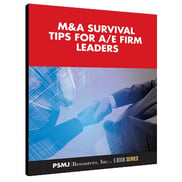

It is a phrase that you’ve probably heard once or twice in M&A discussions over the years. That is…”we’ll buy them with their own money.” As an acquirer, this sounds like a great deal. Attach a valuation of, say, 4x earnings, and then just leave the seller alone and let their future earnings fund the deal. If all goes well, the seller has earned you back the transaction price over four years.
On the surface, this concept really is the basis behind any Return on Investment (ROI) analysis. A future cash flow stream needs to justify a present investment. But, this is a concept that can really drive frustration with sellers. The sentiment is something like “Why the heck should I sell just to give away future earnings that would otherwise be mine.”
We might be making a bit of an overly simplistic example here, but this is an issue that plays out quite frequently in the architecture and engineering space. This is an issue because these three aspects of the deal are either forgotten or misunderstood:
-
Like with any investment, there is no guarantee that future earnings will actually materialize. Client work can dry up, competitors can take business...anything can happen in the years after the deal. Even with the most consistent performers, attitudes and energy can change after the deal and that can have a direct impact on backlog.
-
In many cases, the seller is selling to take money off the table and create some liquidity. Most financial advisors would agree that closely-held illiquid equities aren’t the best place to keep your next egg as retirement approaches. Sure, you can keep on working, but you getting closer to retirement also brings down the value and means three or four more years designing bridges or pounding the pavement for new projects.
-
Here’s where “synergy” comes into play. A key assumption built into the deal is usually that there will be growth opportunities after the deal that neither firm could realize on their own. There is significant value in that (for buyer and seller). Things won’t likely just stay status quo after the transaction.
With these concepts as a backdrop, here are some quick bits advice from the M&A experts at PSMJ. First, as an acquirer, this can often be easier said than done. Know that you are assuming some level of risk in the deal. Maybe not professional liability risk (if the right insurance products and/or deal structure is in place), but a risk that things won’t go as planned.
Second, as a seller, know that the benefit for you here is that you are taking money off the table, getting off the “treadmill” and pushing that future risk and responsibility onto an acquirer. Of course, you can always keep running the firm and keep the proceeds from that. But, at what price? What does that accomplish for your own personal or professional objectives?
 Merger & Acquisition (M&A) activity in the architecture and engineering space is certainly on the upswing and well on its way to reaching pre-recession levels. But, how ready are you for taking on the task of buying or selling an A/E firm? If you are looking for tips to help your firm navigate through the M&A process, check out PSMJ complimentary ebook M&A Survival Tips for A/E Firm Leaders.
Merger & Acquisition (M&A) activity in the architecture and engineering space is certainly on the upswing and well on its way to reaching pre-recession levels. But, how ready are you for taking on the task of buying or selling an A/E firm? If you are looking for tips to help your firm navigate through the M&A process, check out PSMJ complimentary ebook M&A Survival Tips for A/E Firm Leaders. 
Other M&A Related Posts
Getting Ready to Sell? Think Like a Buyer!
What You Must Know About Private Equity
Growing Revenue = Growing Valuation? Be Careful What You Wish For!
Expert Interview: Assessing Current M&A Market Conditons and Trends


